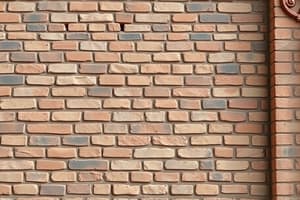Podcast
Questions and Answers
Which of the following is NOT a benefit of brickwork?
Which of the following is NOT a benefit of brickwork?
- Weightlessness (correct)
- Thermal mass
- Durability
- Fire resistance
Bricks provide excellent thermal mass, which helps to regulate building temperatures.
Bricks provide excellent thermal mass, which helps to regulate building temperatures.
True (A)
What tool is used to guide brick placement?
What tool is used to guide brick placement?
String line
The __________ bond is a common pattern used in brickwork.
The __________ bond is a common pattern used in brickwork.
Which of these is a common application of brickwork?
Which of these is a common application of brickwork?
Match the following brickwork bonding patterns with their descriptions:
Match the following brickwork bonding patterns with their descriptions:
A jointer is used for cutting bricks during construction.
A jointer is used for cutting bricks during construction.
Name one aesthetic benefit of brickwork.
Name one aesthetic benefit of brickwork.
Which type of reinforcement is most commonly used in concrete construction?
Which type of reinforcement is most commonly used in concrete construction?
Fiber-Reinforced Polymer (FRP) is known for its high resistance to corrosion and chemical damage.
Fiber-Reinforced Polymer (FRP) is known for its high resistance to corrosion and chemical damage.
What are the characteristics of Glass Fiber-Reinforced Polymer (GFRP)?
What are the characteristics of Glass Fiber-Reinforced Polymer (GFRP)?
___ are short, thin steel fibers added to concrete mix to improve tensile strength.
___ are short, thin steel fibers added to concrete mix to improve tensile strength.
Match the reinforcement materials with their primary characteristics:
Match the reinforcement materials with their primary characteristics:
Which type of reinforcement involves tensioning cables after the concrete is cast?
Which type of reinforcement involves tensioning cables after the concrete is cast?
Expanded Metal is used primarily for better bonding and concrete flow.
Expanded Metal is used primarily for better bonding and concrete flow.
Name two types of synthetic fibers commonly used in concrete.
Name two types of synthetic fibers commonly used in concrete.
What is a primary benefit of using brick structures?
What is a primary benefit of using brick structures?
Cavity brickwork consists of a single layer of bricks for insulation.
Cavity brickwork consists of a single layer of bricks for insulation.
What tool is primarily used to apply mortar in brickwork?
What tool is primarily used to apply mortar in brickwork?
Bricks laid in lengthwise overlapping each course are referred to as __________ bond.
Bricks laid in lengthwise overlapping each course are referred to as __________ bond.
Match the following brickwork techniques with their descriptions:
Match the following brickwork techniques with their descriptions:
Which technique can lead to segregation and air entrainment in concrete?
Which technique can lead to segregation and air entrainment in concrete?
Floating and troweling are finishing techniques used to achieve the desired surface finish in concrete.
Floating and troweling are finishing techniques used to achieve the desired surface finish in concrete.
Name one type of bond used in brickwork that alternates stretchers and headers.
Name one type of bond used in brickwork that alternates stretchers and headers.
Study Notes
Brickwork Tools
- String line: Utilized for guiding the accurate placement of bricks.
- Jointer: Employed for finishing mortar joints, enhancing aesthetic appeal.
Brickwork Benefits
- Durability: Bricks are known for their longevity and resistance to weathering.
- Fire Resistance: Non-combustible nature of bricks provides significant fire protection.
- Thermal Mass: Bricks effectively absorb and release heat, assisting in temperature regulation.
- Aesthetics: Brickwork delivers a unique and visually appealing exterior.
Common Brickwork Applications
- Walls: Used extensively for structural integrity and division of spaces.
- Building Exteriors: Provides an attractive and enduring outer layer.
- Partitions: Ideal for creating internal separations.
- Fireplaces: Commonly constructed with bricks for safety and functionality.
- Patios and Walkways: Popular choices for outdoor flooring due to durability.
Types of Brickwork
- Solid Brickwork: Continuous pattern with no gaps between bricks; robust structure.
- Cavity Brickwork: Consists of two layers of bricks with a gap in between for insulation.
- Veneer Brickwork: A single brick layer adhered to a backing material for aesthetic purposes.
Brickwork Techniques
- Stretcher Bond: Bricks laid lengthwise, each overlapping the one below.
- Header Bond: Bricks laid widthwise, ensuring overlapping for stability.
- English Bond: Alternates courses of stretchers and headers for strength.
- Flemish Bond: Features alternating stretchers and headers, centered for visual appeal.
Concrete Placement Guidelines
- Avoid over-vibration to prevent segregation and air entrainment during the mixing process.
- Choose appropriate tools based on the mix design and placement methods.
- Monitor temperature conditions; adjust placement and compaction techniques accordingly.
- Implement proper finishing methods, such as floating and troweling, for an optimal surface finish.
Common Types of Reinforcement for Concrete
- Rebar (Deformed Bars): Predominantly used, these bars have ridges for better bonding, often referred to as high yield bars (Y-bars).
- Mild Steel Bars: Smoother bars ideal for smaller projects like residential construction, known as R-bars.
- Prestressed Concrete: Utilizes high-strength steel strands that are pre-tensioned before adding concrete.
- Post-Tensioned Concrete: Involves tensioning high-strength steel cables post-concreting.
- Fiber-Reinforced Polymer (FRP): Corrosion-resistant composites suitable for diverse applications.
- Glass Fiber-Reinforced Polymer (GFRP): Lightweight, ideal for rehabilitation projects with corrosion resistance.
Additional Reinforcement Types
- Steel Fibers: Short fibers mixed into concrete to enhance tensile strength.
- Synthetic Fibers: Made of polypropylene or nylon, focused on crack control and impact resistance.
- Welded Wire Fabric (WWF): A mesh of welded steel wires used for reinforcing slabs.
- Expanded Metal: Steel mesh that improves bonding and concrete flow properties.
Studying That Suits You
Use AI to generate personalized quizzes and flashcards to suit your learning preferences.
Related Documents
Description
Explore the essential tools and benefits of brickwork in this quiz. Learn how different types of brickwork contribute to its durability, fire resistance, and aesthetic appeal. Test your knowledge on common applications and the significance of brickwork in construction.




